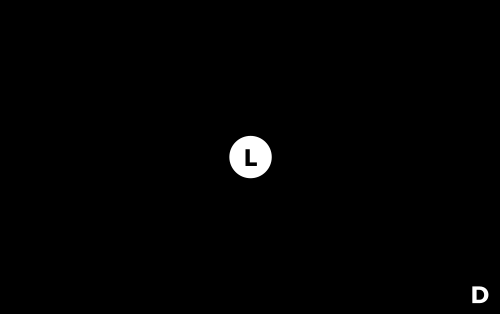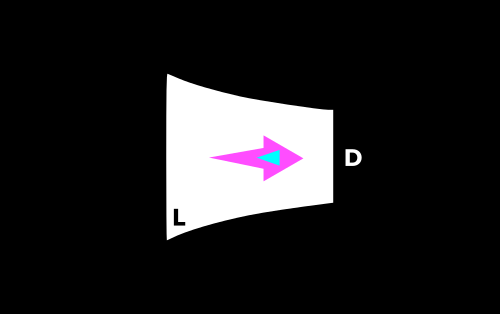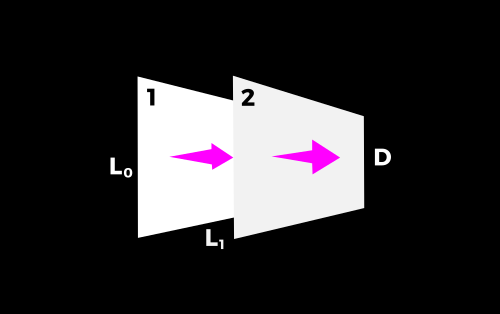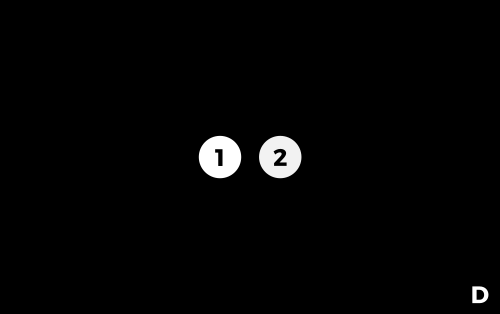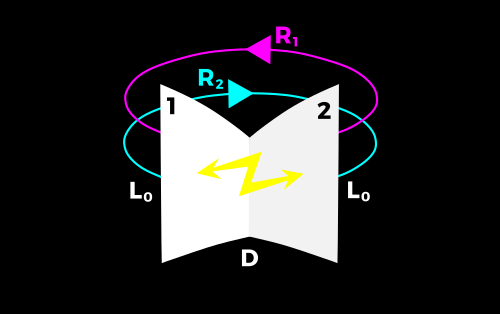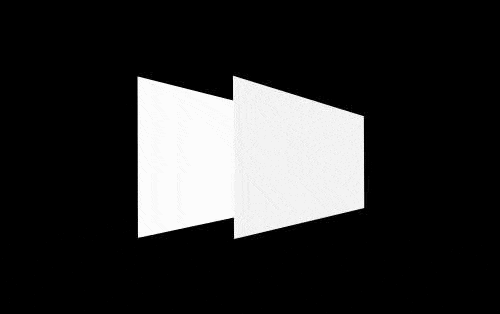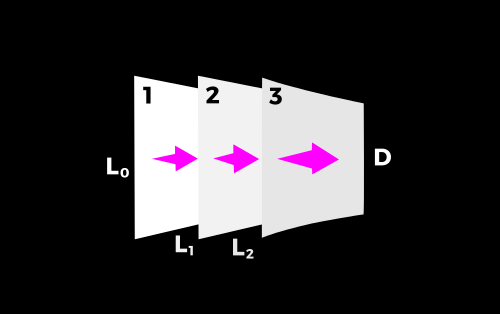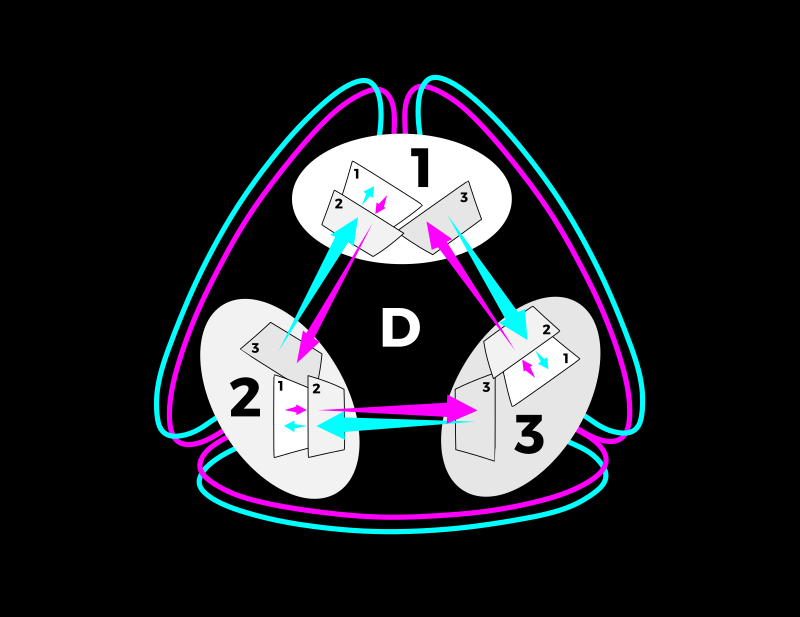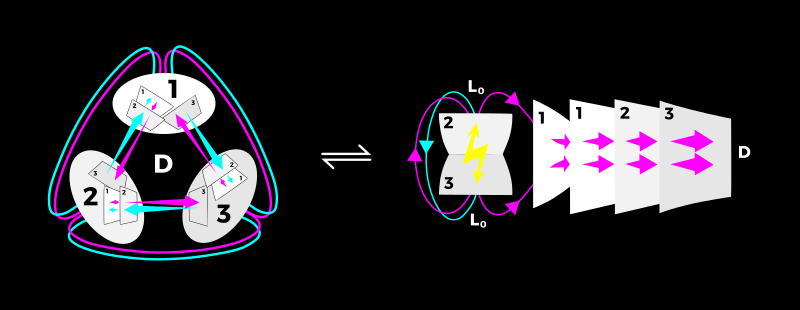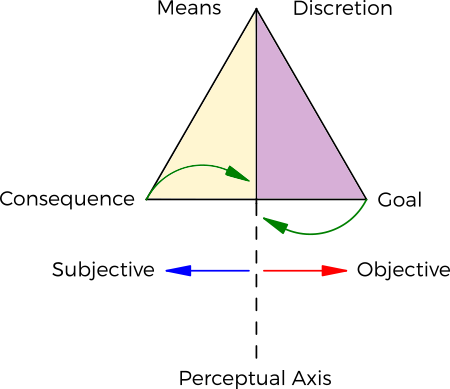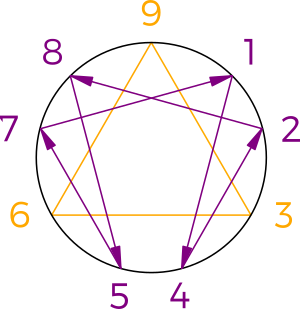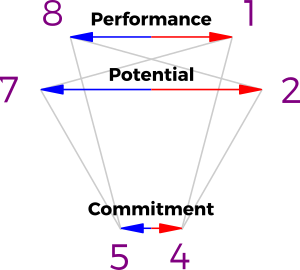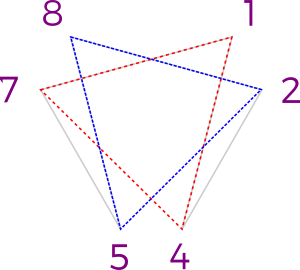Back • Return Home
A Summary of The System of Cosmic Order
Introduction
Robert Campbell, a chemical engineer by profession, had a series of intense spiritual experiences which revealed a collection of archetypal patterns and processes that appear on every level of scale throughout the entire Universe. He generally refers to it as The System of Cosmic Order, or simply The System.
Here, we will attempt to give a basic summary of The System, and help to define the unique terminology that is used to describe it. It may seem complicated, but please have patience for it. We will try to reiterate important points in different ways throughout. This is not intended to be a replacement for any of the work by Robert, merely a supplement to aid in its understanding. If the topic interests you, I highly suggest that you read his works to get a more comprehensive view of it. As The System appears Universally, it has broad application, and Robert shares many fruitful avenues for further exploration. It touches upon everything from history, to biology, to physics, to language, and more.
To get straight into it...
System 1: Universal Wholeness
This diagram shows a Center of Light, represented by L, and a Periphery of Dark, represented by D. Both of these are Universal in nature. In other words, on the most fundamental level of reality, All things have a common Center and share a common Periphery. Hence, this is called Universal Wholeness and represents a Oneness that trancends All things.
Let's take a different view of the same:
This diagram shows the Center of Light as an "unbounded" plane (i.e.: one of indeterminate extent). Since it is Universal, it cannot enclose anything in Partcular. If it did, then it would cease to be Universal! A Center with this characteristic will be referred to as an Open Center.
We can also call it an Active Interface. This emphasizes the fact that the plane does not simply divide an inside from an outside, but that it is a surface through which information is interchanged. In this case, this interchange is represented by the magneta arrow moving from inside-to-outside (called Efflux), and the cyan arrow moving from outside-to-inside (called Reflux).
So, to repeat:
The view on the left is known as a Passive Perspective. It delineates a static structure. The view on the right is known as an Active Perspective. It describes a dynamic relationship.
Again, they are two different views of the same thing! Together they will be referred to as a Term. A Term tells us one way that L and D relate to one another. System 1 has only one Term.
System 2: The Rift In Wholeness
Let's add another Center:
We now have two Centers nested inside of one another like concentric spheres; we will label each of them with a number. What does this mean symbolically?
If Center 1 represents a Universal Wholeness, that which transcends all archetypes, then we can think of Center 2 as representing a specific archetype. It is like a process of "individualization" or "differentiation", a partial separation into something seemingly unique, a Rift In Wholeness so to speak. In this context, we will refer to Center 1 as Idea and Center 2 as Form. Both Centers are still Universal, but relatively speaking, Center 1 is more so.
Let's look at the Active Perspective of the same:
Notice that there is an Efflux through both Centers, from inner Idea to outer Form. To put it another way, a Universal Idea guides archetypal Form. Also notice that the two Centers make a gradient. This change in intensity is represented by L with a subscript numeral (i.e.: L0 and L1). The higher the number, the further out from Center 1 it is.
Together, these are the Passive and Active Perspectives of Term 1:
We will call this the Objective Term of System 2.
The orientation of the Centers relative to one another can change. For example, instead of being nested, they can also seem to face each other:
To look at the Active Perspective of this:
There is both an Efflux and a Reflux that link the Centers together in a way that is cyclic. These are called Relational Wholes and are represented by R with a subscript numeral (i.e.: R1 and R2). A Countercurrent Identity is when two complementary Relational Wholes exist in parallel to one another.
When two Centers function together as One, it is called Coalescence, and this "mutual recognition of Oneness" is represented by a yellow zig-zag arrow. To briefly explain...
While they seem to face one another, the two Centers are not actually separate from one another. The Particular only makes sense in reference to the Universal! As stated before, Center 1 can be thought of as more Universal than Center 2.
Taking the two previous views together gives us Term 2, the Subjective Term of System 2:
Generally, things which occur inwardly are considered "Subjective", while those that occur outwardly are considered "Objective", but at what point does each become the other? We seem to continually move from Objective action to Subjective contemplation, and vice versa. This is represented by an oscillation between the two Terms of System 2:
Notice that Center 2 is turning around, almost as if it was being flipped inside-out. This makes the Objective Term into the Subjective Term, and vice versa. This oscillation is called a Perceptual Transposition, and the point around which we "flip" is referred to as the Master Interface or Axis. It is the connection between the Subjective and the Objective.
It is important to keep in mind that there are not only relationships between Centers, but also between Terms (i.e.: "permutations", or specific orders, of Centers).
System 3: The Primary Activity
You might be able to guess what we are going to do next. We will add another Center:
In this case, Center 1 will be called Idea, Center 2 will be called Routine, and Center 3 will be called Form.
Looking at the Active Perspective of this we get:
When we take both Perspectives, we get Universal Term 1 (UT1), or the Discretion Term, of System 3:
Notice its similarity to the Objective Term of System 2. What is this supposed to symbolize?
System 3 is known as The Primary Activity because it describes an aspect of creation that occurs everywhere, an "activity" which is "primary". In short, everything has an Idea that lies behind it, which in turn, directs the Routine that gives it Form. We select Ideas at our Discretion. Therefore, this Term is describing something like a Universal will, an energy which selects Ideas. This might seem somewhat abstract, but hopefully it will become more clear as we continue on...
This is Universal Term 2 (UT2), or the Means Term, of System 3. Again, notice its similarity to the Subjective Term of System 2. What does this symbolize?
The Means Term is describing a process of feedback wherein a Routine is refined to make a Form more closely correspond to the Idea that lies behind it.
To be more specific, Idea relates to Form through a Routine (R1), and Form relates to an Idea through a Routine (R2). This Countercurrent Identity shows that the Relational Wholes have a kind of reciprocal relationship to one another. If we thought of the Routine as a Perceptual Axis, then the Idea is "Subjective to the Routine" (meaning that the Idea exists inside of the one carrying out the Routine), while the Form is "Objective to the Routine" (meaning that the Form has an existence somewhat distinct from the Routine that brought it about).
In general, this Term revolves around the Means by which something is done.
Both the Discretion Term and the Means Term are Universal. In other words, they are relationships which apply to every type of Idea, Routine, and Form.
The next Term that we will cover is Particular Term 3 (PT3), or the Goal Term, of System 3:
This Goal Term shows a Coalescence of Routine and Form inside of Idea. In other words, every Idea has Routines and Forms that are inherent to it. For any Idea that we select, associated Routines and Forms are implied. In a sense, every experience has a Goal, some memory which arises from it. Therefore, this Term symbolizes a "unit of memory". This Term is Particular, meaning that it denotes something specific, a specific memory.
[Note: Robert would refer to the aggregate of All "unit memories" as The Void, or less frequently, The Quantum Sensorium. One might think of it as synonymous with the word "Akasha", a sort of Cosmic repository of All experience. There is science behind all of this (i.e.: how unit memories are related to the inert gases and various electrical phenomena), but we won't cover that here.]
The last Term of System 3 is Particular Term 4 (PT4), or the Consequence Term:
Notice that each of the three Centers has been folded in on itself to make a kind of ring. These are Closed Centers (as distinct from the Open Centers mentioned earlier). When we have three Closed Centers linked up in this manner, it is called a Triadic Identity. A Triadic Identity is representative of a specific physical entity locatable within space and time. Therefore, like the previous Goal Term, this Consequence Term is also Particular. A physical entity is the Consequence of the process of creation described by The Primary Activity! Whereas System 1 and System 2 delt with the archetypal, System 3 is the beginning of manifest things (as exemplified by this Consequence Term in particular).
We will take a moment to give each of the Centers within this Term a Boundary Condition. In other words, let's relate them to something tangible...
On the cell level:
• Center 1 would represent the "Nucleic Acids" ("DNA"/"RNA"), the Idea behind the cell.
• Center 2 would represent the "Organelles", that which carries out the Routines of the cell.
• Center 3 would represent "Molecular Synthesis", the material which makes up the Form of the cell.
On the body level:
• Center 1 would represent the "Host", the overarching Idea that gives coherence to the body.
• Center 2 would represent the "Organs", that which carries out the Routines of the body.
• Center 3 would represent the "Cells", the units which make up the Form of the body.
Notice that it is the same general pattern on two different levels of scale, and further, that these two levels can connect to one another. The patterns described by System 3 can be projected up and down to any size "thing" to derive useful information about it. The System transcends space and time!
Finally, there is also a relationship between all four of the Terms of System 3. The Universal Terms UT1 and UT2 act upon and through the Particular Terms PT3 and PT4. To demonstrate, the Discretion Term selects a Goal Term:
This merger of UT1 and PT3 is called the Quantum Frame. It represents a Universal will selecting unit memories.
Likewise, the "parts" of the Consequence Term are kept in alignment with one another through the Means Term:
This merger of UT2 and PT4 is called the Space Frame. It represents Particular manifestations seeking balance within themselves and each other.
Just like the Perceptual Transposition between the Objective Term and Subjective Term of System 2, there is an continual oscillation between the Quantum Frame and the Space Frame of System 3:
It is also represented more simply as a triangle which can flip around:
Again, this Primary Activity symbolizes how All things come into existence! They begin as a Universal potential that is translated into a Particular manifestation by choice. There are also hints as to how these manifestations develop...
Notice that there is a top-down organization to the Centers within the Space Frame. To put it another way, it moves counter-clockwise from Idea, to Routine, to Form. This pattern is called the Evolutionary Variant; it describes integration and growth. If one was to go through the Centers backwards (i.e.: clockwise from Form, to Routine, to Idea), then it would describe a process of fragmentation and decay, an Involutionary Variant:
This seems to signify that the Means Term has become corrupted within the Involutionary Variant, but it can also be "redeemed" by transforming its activity into an Evolutionary Variant once more! The Universal Idea always comes before the Particular Form.
System 4: The Primary Creative Process
Whereas System 3 describes the beginning of creation, System 4 elaborates upon how it unfolds. It is somewhat complex and takes a little bit of patience to understand all of the patterns and processes. Before we continue on, we would like to point out two very important points about The System as a whole:
1. Every successive System is like a higher resolution photo of what is already there. More detail is added, but previously introduced Universal patterns persist throughout. For example, we noticed earlier how aspects of System 3 were similar to those of System 2. Again, the entirety of The System is always there, but every successive level (i.e.: System 1, System 2, System 3, etc.) gives more specific details!
2. These details, especially the information within the Active Perspective of each Term, are an "emergent property". This means that they cannot be logically deduced from previously introduced Particular patterns. They can only be known through personal intuitive insight, an experiential knowing of The Cosmic Order. The more you humbly seek to understand, the more that it will reveal itself to you.
[For those that are mathematically inclined, the only aspect of The System that can be derived logically is the general structure of the Passive Perspectives. The nesting of Centers is similar to the "balanced parentheses" or "bracketing problem" in "Combinatorics", the branch of mathematics that deals with "permutations", or placing things within a specific order. In short, they follow a "recurrence relation", or repeated looping, that can be described with the sequence of "Catalan numbers".]
So far, we have found that...
System 1 has one Center making one Term,
System 2 has two Centers making two Terms, and
System 3 has three Centers making four Terms.
Continuing with this sequence, System 4 has four Centers making nine Terms.
The names of the Terms in System 4 are somewhat variable, depending upon what it is applied to or the aspect of the Term that we are homing in on. Paying careful attention to the relationship of the Centers within each Term should make their meaning clear no matter what name is given. However, we will attempt to consistently use the most widely applicable names throughout!
Please note that we will present the Terms in an order different from how they are actually numbered. We will start with Term 9: Discretionary Hierarchy...
Again, we see a similarity to the Discretion Term of System 3, the Objective Term of System 2, and the single Idea Term of System 1. In fact, every layer of The System will have a Discretionary Term that operates from the inside to the outside like this. It symbolizes something Universal, so it is omnipresent!
In this case, Center 1 represents Idea, Center 2 represents Knowledge, Center 3 represents Routine, and Center 4 represents Form.
Each naturally leads into the next. We select Ideas, associated with some bit of Knowledge, connected to Routines that give rise to Forms. The Primary Creative Process, how things develop, is an elaboration of The Primary Activity, the act of creation itself.
The next is Term 3: Transference of Idea...
The full name of this Term is Transference of Idea Into Form (though it is usually shortened to Transference of Idea or Idea Transference). It is similar to the Means Term of System 3. It describes the process by which Ideas are translated into Forms.
While all of those lines might look like a tangle of spaghetti, each Relational Whole is merely demonstrating how the Centers relate to one another. For example, R1 relates Center 2, Knowledge, to Center 3, Routine. R2 goes in the reverse direction. The yellow zig-zag arrow shows a Coalescence between Knowledge and Routine.
We can follow all of the other arrows to demonstrate similar patterns: R3 relates Knowledge to Form through Routine, R4 relates Routine to Idea through Knowledge, etc. Everything is carefully balanced with the Transference of Idea.
The next is Term 6: Corporeal Body...
Notice the Triadic Identity within this Term. A Corporeal Body is a distinct physical entity. The Projections (labeled P1, P2, and P3) are the Ideas, Knowledge, and Routiness of that entity being extended out into the environment through its Form. It is almost like a combination of the Goal Term and Consequence Term of System 3. Just as a Consequence often comes as the result of some Goal, a Corporeal Body often arises with the Transference of Idea Into Form.
So far, we have seen three Terms of System 4, and all of them have been similar to ones that we have seen in System 3. However, instead of referring to the beginning of manifest things, we are starting to see how those things interact with their surroundings.
The next we will cover is Term 1: Perception of Field...
We now have a Term with its own Perceptual Axis explicitly pointed out. This is suiting, as by Perception of Field we are referring to something perceiving its own environment. The Coalescence between Idea and Knowledge, and between Form and Routine, are showing this relationship between inside and outside. Note the similarity of this Term to the Subjective Term of System 2.
The next is Term 4: Organized Input...
Whenever we take in sensory data, there is a Routine that references the Forms that we perceive to our prior Knowledge and potential Ideas. In other words, the Input is Organized. Hence, the name of this Term is Organized Input. Notice how this reaction naturally follows from the stimulus provided by the previous Term, Perception of Field.
The next is Term 2: Creation of Idea...
The Relational Whole R1 is showing Form triggering an Idea through a Routine, the literal Creation of Idea from the Organized Input within the previous Term. Like the Consequence Term of System 3, the Triadic Identity within this Term is a unit which contains an Idea, some Knowledge, and a Routine that are all united as one. This union is symbolized by the double loops that relate them to one another and connect all of them together.
The next is Term 8: Balanced Response...
Knowledge is a balance between the Ideas within us (represented by the Projection P2), and the feedback that we receive from the Forms and Routines of the environment (represented by Projection P1). This balacing act is symbolized here by the Relational Wholes R1 and R2.
The next is Term 5: Physical Action...
If the previous Term was to generate a Balanced Response to the Creation of Idea within Term 2, then this Term would be to carry out that response as a Physical Action. The Relational Wholes R1 and R2 are Efflux and Reflux, respectively. In other words, the Idea is expressed through Knowledge and Routine (R1), and the result is reflected back in Form (R2).
And finally, there is Term 7: Memory Resources...
The six Terms that we have just encountered describe a process: Term 1 → Term 4 → Term 2 → Term 8 → Term 5 → Term 7
We had a Perception of Field, and from the Organization of the sensory Input from that Perception, an Idea was Created. A Balanced Response arose from that Idea, and was carried out as a Physical Action. This Action lead to the creation of another unit memory that has become a part of our Memory Resources (represented by the Coalescence between Form and Routine inside of Knowledge and Idea within this last Term).
While it may seem like a linear sequence, it is actually cyclic. The Memory of Term 7 influences the Perception of Field in Term 1. What we've experienced colors what we perceive. This is called Historic Integration, and it is how we transcend space and time! [The importance of this self-modifying pattern cannot be emphasized enough. Later, we will use it to describe how "genetic information" is expressed and passed on from generation-to-generation, and how "neurons" learn and adapt.]
In summary, we have seen all nine Terms:
• Term 9: Discretionary Hierarchy
• Term 3: Transference of Idea
• Term 6: Corporeal Body
• Term 1: Perception of Field
• Term 4: Organized Input
• Term 2: Creation of Idea
• Term 8: Balanced Response
• Term 5: Physical Action
• Term 7: Memory Resources
There are two different versions of the last six Terms (i.e.: 1, 4, 2, 8, 5, and 7). These different versions are called Modes. Here, all of the Terms are shown in Expressive Mode. This means that they represent an action based upon Idea, an expression of resources or release of energy. If we switch the position of Center 1 and Center 2 within each of these Terms, then we get the Regenerative Mode. The Regenerative Mode represents a simulation of action based upon Knowledge, a regenerating of resources or replenishing of energy. To reiterate: Expressive action, Regenerative simulation. We will distinguish between each of these with a letter. For example, "T1E" would mean "Term 1, Expressive Mode", while "T4R" would mean "Term 4, Regenerative Mode".
Like the "flip-flop" of the Perceptual Tranpositions within System 2 and System 3, each Term in System 4 triggers another Term in a specific order. This is called a Transformation Sequence. There are five Transformation Sequences occuring in parallel. We will refer to all of the Terms involved in each Transformation Sequence as a Set. These Sets are:
• The Primary Universal Set (U1), made up of the Terms T9 and T8R
• The Secondary Universal Set (U2), made up of the Terms T3, T6, and T2E
• Three Particular Sets (S1, S2, and S3), each of which is made up of the Terms T8E, T5E, T7E, T1E, T4E, T2E, T5R T7R, T1R, T4R, and T2R
Since there are five Sets, one for each of the five Transformation Sequences, this terminology is often used interchangably. To reiterate: Sets are just groupings of Terms, and Transformation Sequences are the order in which those Terms transform into one another.
All of this might sound unwieldy, but it follows a simple pattern. Here is a table that lays out all five Sets and their Transformation Sequences. We will call it The Evolutionary Matrix:
| U1 |
U2 |
S1 |
S2 |
S3 |
Step |
Cycle |
| T9 |
T3 |
T8E |
T7R |
T4E |
1 |
#1 |
| T9 |
T6 |
T5E |
T1R |
T2E |
2 |
|
| T8R |
T6 |
T7E |
T4R |
T8E |
3 |
|
| T8R |
T2E |
T1E |
T2R |
T5R |
4 |
|
| T9 |
T3 |
T4E |
T8E |
T7R |
5 |
#2 |
| T9 |
T6 |
T2E |
T5E |
T1R |
6 |
|
| T8R |
T6 |
T8E |
T7E |
T4R |
7 |
|
| T8R |
T2E |
T5R |
T1E |
T2R |
8 |
|
| T9 |
T3 |
T7R |
T4E |
T8E |
9 |
#3 |
| T9 |
T6 |
T1R |
T2E |
T5E |
10 |
|
| T8R |
T6 |
T4R |
T8E |
T7E |
11 |
|
| T8R |
T2E |
T2R |
T5R |
T1E |
12 |
|
[Note: All of the Terms in Regenerative Mode are shown in italics within the table.]
Starting from the left of the table, each column shows the Transformation Sequence associated with each Set. For example, the first Term within the Transformation Sequence of the first Particular Set (S1 shown in red) is the Expressive Mode of Term 8. It transforms into the Expressive Mode of Term 5, which transforms into the Expressive Mode of Term 7, and so on down the column. T8E → T5E → T7E → ...etc.
It takes twelve steps for this entire process to repeat. Again, instead of simply bouncing back-and-forth between two Terms like the Perceptual Transposition of System 2, or even two groups of Terms like the Perceptual Transposition of System 3, we are looping through a whole sequence of them in System 4!
There are five of these loops in parallel. Two of them are Universal (the columns labeled U1 and U2), and three of them are Particular (the columns labeled S1, S2, and S3). Therefore, all of the Terms within the same row of the table are occuring simultaneously. They all synchronize, or seem to return to the point where they all started from, after twelve steps.
However, notice that there is also a difference between the Transformation Sequences of the Universal Sets and those of the Particular Sets. The Terms within the Universal Sets seem to repeat every four steps. This is called a Cycle. This would mean that the Universal Sets make three Cycles for every repetition of the Particular Sets. For example, the Transformation Sequence for The Primary Universal Set (U1) is Term 9 repeatedly transforming into the Regenerative Mode of Term 8, and vice versa. T9 → T9 → T8R → T8R → ...repeat. [Note: "T9 → T9" means that the Term is held in place for the duration of two steps.]
Further, T8R is Universal while T8E is Particular. In other words, Term 8 only ever appears in the Expressive Mode within the Particular Sets and in the Regenerative Mode within The Primary Universal Set. It acts as a link or pivot between the two Modes. For example, notice that T8E shows up twice within each Particular Set, right before switching into a string of Terms in either Expressive Mode or Regenerative Mode. Just to be clear, the Terms in the Universal Set apply everywhere, whereas those within the Particular Sets apply to specific things (much like the Closed Centers of the Consequence Term within System 3). This distinction between Universal and Particular is important. It tells us how broadly a Term may be applied at any given moment. To reiterate: The Particular Sets focus upon specific activities, while the Universal Sets integrate what they are all doing.
...This might seem like a lot of information to take in. Let's "parse" it (i.e.: break it down into more manageable chunks)!
Thankfully, there is a much simpler way to describe all of these Terms and the steps that they are making. This is done through a symbol called an Enneagram:
The prefix "ennea-" means "nine", and the root "-gram" means "marking" or "symbol". Thus, it is a "symbol of nine".
Remember, System 4 has nine Terms. Each point on the diagram represents a Term! To elaborate...
Notice that there is a kind of purple star-like pattern. This is called a "hexad" (from the prefix "hex-" meaning "six"). It connects together the numbers 1, 4, 2, 8, 5, and 7. These are the Terms involved in the Particular Sets, and the arrows show the direction of their Transformation Sequences. They are like the steps of a dance. To illustrate:
Follow one of the Particular Sets (S1, S2, or S3) with your finger to see how it traces a path through the hexad. Each Particular Set is one step ahead or behind the others. [It is similar to a "musical canon", like "Row Row Row Your Boat". Some voices "lead" and others "lag".]
With every step, the overall position of the Particular Sets seems to mirror across the Perceptual Axis. Robert gives a rhyme for remembering this motion:
"Particular Sets take alternate steps
to see themselves in the mirror."
The "mirror" being referred to in this line is the Perceptual Axis. Each Particular Set alternates across the Perceptual Axis until it ends up in the position directly across from it. Compare step 1 and step 4.
Notice that each Particular Set must go through six steps in order to complete one circuit through the hexad, but since there are two Modes, it takes each Particular Set twelve steps in total. Seven of those steps are Expressive, five of them are Regenerative, and it is always Term T8E which links both of the Modes together. Both Modes are necessary because they bring balance to one another.
The next thing that we will focus upon within the Enneagram is the orange triangle that connects together the numbers 3, 6, and 9. Like the triangle that was used to describe the Perceptual Transposition of System 3, the Universal Sets of System 4 can also be symbolized with the flipping of a triangle, albeit one that is a little more vigorous in its motion. This triangle is called The Mediating Triangle because it "mediates", or controls, the Perceptual Transpositions within System 4:
The flip of The Mediating Triangle is controlled by The Primary Universal Set U1. The Perceptual Axis of The Mediating Triangle directs The Secondary Universal Set U2. Follow where U1 and U2 go within each step. This might seem a little confusing at first, but it will become more clear as we continue on. Robert gives a rhyme for remembering this motion too:
"Universal Sets take double steps
to flip themselves round with the mirror."
The "double steps" are how Terms are being held in place for two steps. In the above diagram, notice how U1 stays at position 9 within steps 1 and 2, and stays at position 8 within steps 3 and 4. Similarly, U2 stays at position 6 within steps 2 and 3. One pauses while the other moves. Again, these are the "double steps" of the Universal Sets. They build a "continuity", or bridge between the activities of both of the Universal Sets!
At the end of four steps, the Universal Sets and the Perceptual Axis shift back to their original positions. This is called a Shift Transformation. It symbolizes a "discontinuity", or gap, between what each Universal Set is doing. In other words, they both transform at the same time, so the bridging symbolized by the "double steps" is lost for a moment at the end of each Cycle.
Robert has another rhyme to account for the motion of both the Universal Sets and the Particular Sets when they are taken together (i.e.: the whole 12-step pattern, 3 Cycles of 4 steps each):
"Particular Sets reflect in four steps
that repeat with three flips of the mirror."
The "three flips of the mirror" refers to the three Cycles. Again, each Cycle ends in a Shift Transformation, a "flip of the mirror" as it were. To reiterate: The images above focus in on the first four steps within Cycle #1. Robert has also made a wonderful little animation that demonstrates these same movements...
Photo Credit: Cosmic-Mindreach
[Note: The yellow circles are the Universal Sets, while the circles of every other color are the Particular Sets.]
...and to combine all of the rhymes together into a short poem:
"Particular Sets take alternate steps
to see themselves in the mirror.
Universal Sets take double steps
to flip themselves round with the mirror.
Particular Sets reflect in four steps
that repeat with three flips of the mirror."
In summary: The first line of the poem describes the motion of the Particular Sets, the second line describes the motion of the Universal Sets, and the last line describes the relationship between the Universal Sets and Particular Sets (i.e.: 3 Cycles of 4 steps each; 3 × 4 = the whole 12-step pattern). The animation shows what both the Particular Sets and Universal Sets do in Cycle #1.
While it may take some careful meditation on the above for it to start to become apparent, the entirety of System 4 is rhythmic. The Transformation Sequences within the Enneagram are not "random".
Let's explore a few more connections within the Enneagram that show how the Terms interact and support one another on every level...
If we look at the Terms directly across from each other within the hexad, we get three pairings:
These pairs of Terms are called Polar Dimensions, and they give us an insight into three different aspects of whatever System 4 is being applied to at any given moment.
• The combination of Term 1: Perception of Field and Term 8: Balanced Response tells us something about the Performance of that thing
For example, we can understand how our perception of our environment affects our response to it, and how this is related to our Performance.
• The combination of Term 2: Creation of Idea and Term 7: Memory Resources tells us something about the Potential of that thing
For example, we can understand how the creation of ideas is often founded upon memories, and how both inspiration and experience influence the expression of our Potential.
• The combination of Term 4: Organized Input and Term 5: Physical Action tells us something about the Commitment of that thing
For example, we can understand that how we organize information and carry out actions is an indication of the Commitments that we have made.
Because there are three Particular Sets (S1, S2, and S3), one Term from each Polar Dimension is always engaged.
This might sound very abstract, but it becomes clearer the more that we continue to explore it (especially as we start to relate System 4 to tangible things like we did briefly with System 3). Being able to determine these Polar Dimensions is important on a personal level (e.g.: it can help us to effectively direct our own behavior because our nervous system follows System 4), and on an interpersonal level (e.g.: it can help us to design businesses and other social organizations which are sustainable because they follow the Evolutionary Variant patterns of System 4).
The six Terms within the hexad can also be approached in another way:
• Term 1: Perception of Field, Term 4: Organized Input, and Term 7: Memory Resources are referred to as Structural Regions. Their main focus is on things external to the system at hand. Therefore, they are "centrifugal", seeming to push all aspects of it apart. To reiterate: 7-1-4 = Structural Regions
• Term 2: Creation of Idea, Term 5: Physical Action, and Term 8: Balanced Response are referred to as Process Regions. Their main focus is on things internal to the system at hand. Therefore, they are "centripetal", seeming to push all aspects of it together. To reiterate: 2-8-5 = Process Regions
Notice that The Mediating Triangle flips into the 2-8-5 position during the Transformation Sequence of The Primary Universal Set U1.
Terms 2 and 5 are Tensionally Coupled to one another, meaning that what each of them describes is interconnected. Notice that a Physical Action is a reflection of the Creation of Idea. Both of these Terms continually occur together within the Step across all Particular Sets. A similar Tensional Coupling occurs between Terms 4 and 7. Compare the layout of the Centers within these two Terms and notice how they seem to be inversions of one another. In Term 4, there is a Coalescence between Centers 1 and 2, while in Term 7 there is a Coalescence between Centers 3 and 4. To reiterate: There is a Tensional Coupling between Terms 2 and 5, and between Terms 4 and 7. [This drives all of the Particular Sets forward in the Transformation Sequence, like the stages within an internal combustion engine.]
This concludes our summary. We will continue to apply The System to a variety of different subjects within future articles.
Thank you for reading!
